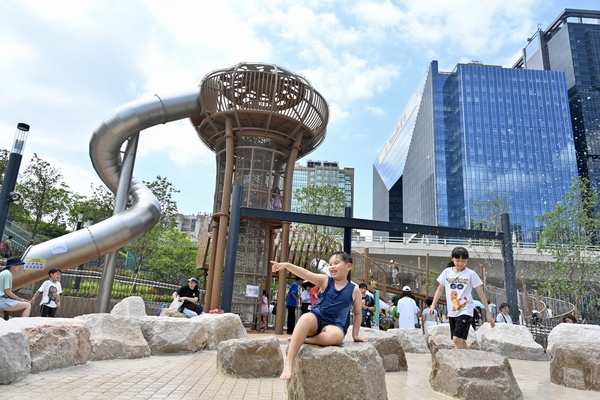Govt, Community-created Dream Park

Apart from serving a practical purpose on the inside, the sewage pumping station in Kwun Tong now doubles as a deck park thanks to the Drainage Services Department and its goal of fulfilling the Government’s "single site, multiple use" initiative and accommodating the needs of the community.
The newly-opened Cha Kwo Ling Promenade has become a new spot for people to spend their time and have fun.
The landscaped deck of the promenade, or the “Pump Park”, actually built on the roof floor of the Kwun Tong Sewage Pumping Station, illustrates the Government’s objective of developing multipurpose public facilities under the "single site, multiple use" model. It also shows the Drainage Services Department’s intention to listen to and serve the needs of the residents.
Community designed
Drainage Services Department Senior Engineer (Harbour Area Treatment Scheme) Doris Choy pointed out that the Pump Park was not the original design.
“During the consultation process, different groups expressed their desire to have more public spaces. The project team therefore changed the original green roof design into a deck park created by the latest design concept and fully opened it for public use to meet the needs of citizens.”
Apart from adding that the department modified the design and nature of the park to provide what the community wanted, she explained that during the construction process, the project team consistently listened to different stakeholder’s opinions, such as residents nearby, the District Council and the Harbourfront Commission, with a view to understanding their expectations of the park and improving its design.
The result of a survey of about 400 respondents living in Kwun Tong by the department showed that participants hoped that the park could have more play facilities for kids. Consequently, the team invited the Playright Children's Play Association to be the project’s play consultant, joining hands to inject novel elements into the park.
Collaborative effort
The team and the association jointly organised a series of public engagement activities which included workshops for children and parents to design what they envision as their dream park.
The eight-metre-tall tree house, called Forest Hunt, is the largest play facility in the park and it actually originated from kids’ creativity. Children can climb up to the top to enjoy the stunning overview of the landscaped deck and play on its exciting slides.
In a design workshop titled “Junior Playground Planner”, children created models of their ideal play facilities and subsequently came up with the very draft design of the Forest Hunt. The architects and engineers of the project team then modified and developed the draft design into a specific prototype before completing the final layout.
Drainage Services Department Engineer (Harbour Area Treatment Scheme) John Mui summarised what he described as a marvellous collaboration between kids and adults.
“We can say that the tree house is designed by children, improved by parents, refined by the designers and implemented by the engineers.”
With the theme of “Playful Nature”, the 1.1-hectare landscaped deck of the Cha Kwo Ling Promenade features more than 60 play facilities that the public can enjoy. The most popular facility is the water play area.
John Mui emphasised that the water play facility was the most anticipated option in the residents’ survey. He added that as a result of a comprehensive analysis of 274 play spaces in the area, the team learnt that Kwun Tong lacks play space for children aged 0 to 2and also for bouncing play experience,. The team therefore put emphasis on such aspects in the park.
Win-win coexistence
Building a park on top of a pump station enabled the coexistence of sewage and leisure facilities in the same space. It also covered the unpopular public facilities with an additional space that the public can use. In addition to serving as a shining example of the Government’s "single site, multiple use" initiative, transforming it into a park also reduced the "Not in my backyard” syndrome in the community.
Ms Choy highlighted that the team adopted the people-centred design approach in the construction process and allowed citizens to participate and contribute in it from the user perspective, seeking innovative ways together to ensure that the park is better suited to the residents’ needs.
Upon concluding the entire project, Mr Mui stated that letting children participate in the design of the play facilities was the equivalent of making their dreams come true and now the Pump Park is truly fun and playful.
Construction Robots Enhance Efficiency
For the Trunk Road T2 & Cha Kwo Ling Tunnel project, the Civil Engineering & Development Department has applie... Read more
HK's Smart Development Recognised
Hong Kong has placed significant emphasis on smart transformation and development in recent years – and its efforts ... Read more
Hotline Eases Carers' Burden
Mrs Lee, 74, and her 84-year-old husband are a doubleton elderly household relying on Comprehensive Social Security As... Read more
District Governance: Cameras Boost Security
Whether at busy intersections or tranquil street corners, Hong Kong has silent sentinels safeguarding citizens. Thr... Read more
Meals Tailor-made For Patient Needs
The bustling kitchen of Kowloon Hospital serves approximately 1,400 inpatients per meal. The menus are designed to ... Read more
Talent Volunteers Share In Festive Fun
Staged ahead of the Mid-Autumn Festival, a lantern workshop organised by the Talent+ Volunteer Programme, run by Hong ... Read more

